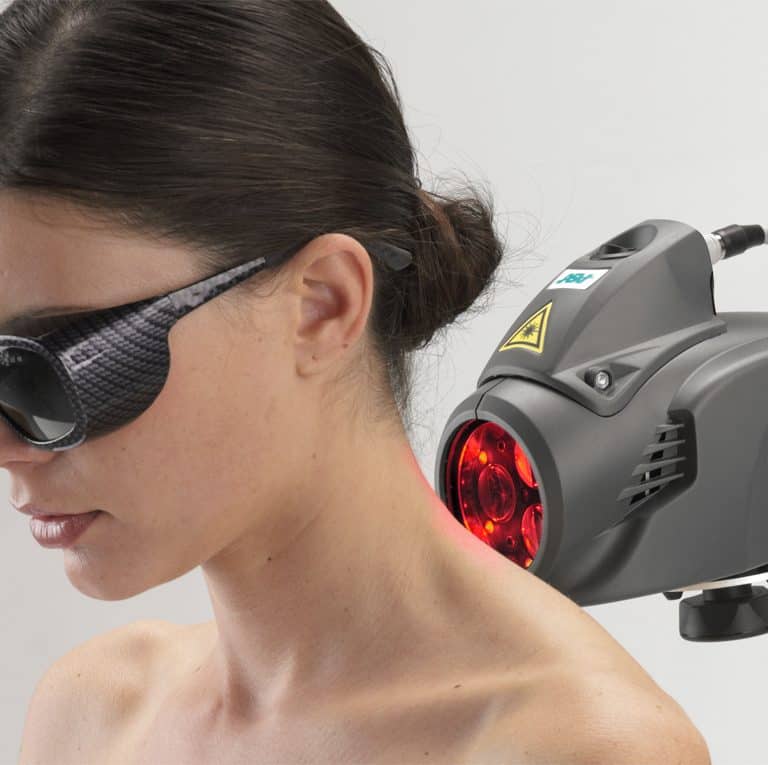MLS LASER THERAPY
MLS Laser Therapy helps overcome the painful symptoms typical of musculoskeletal disorders which means patients return to everyday activities faster.

Reduction in pain
Reduction in pain from pathology, trauma, iatrogenic, pre-operative and post-operative.

Reduction in oedema
Reduction and prevention of oedema associated with disease, injury or potentially post-treatment. Can be used to ameliorate or prevent oedema.

Biostimulation
Promotes improved healing of soft and hard tissue damage caused by pathology or post-operative.
What is MLS Laser Therapy?
Multiwave Locked System or MLS Laser Therapy is an advanced medical technology designed to significantly reduce pain, inflammation, and promote tissue healing. It is non-invasive and used for a variety of conditions, including musculoskeletal injuries, arthritis, neuropathy, healing and post-surgical recovery.
MLS Laser Therapy was developed by ASA Laser to help overcome the disadvantages of traditional laser therapy and is now incorporated in their range of laser devices.
How Does MLS Laser Therapy Work?
MLS Laser Therapy uses a patented dual-wavelength system to deliver precise therapeutic laser energy to affected tissues. Unlike traditional laser devices that use a single wavelength, MLS technology combines two synchronised wavelengths:
808 nm as a Continuous Wave – This wavelength penetrates deeply to reduce inflammation and oedema (swelling) by improving lymphatic drainage and circulation for a strong anti-inflammatory effect.
905 nm SuperPulsed Laser – This wavelength is primarily responsible for pain reduction, as it stimulates cellular activity, reduces nerve sensitivity, and enhances tissue regeneration.
The two therapeutic wavelengths are precisely synchronised to work in harmony, enhancing their combined effects on the tissues. This exact coordination results in a more powerful therapeutic response, where the reduction of swelling and pain is greater than what either wavelength could achieve alone. MLS is patented and exclusive to the range of ASAlaser devices.
For the practitioner and the patient, continuous and pulsed emissions means the effective treatment of pain, inflammation and oedema in the one treatment session in.
Understanding the advantages of MLS
The 905 nm laser used in MLS® technology is a true superpulsed laser, unlike many so-called pulsed lasers that simply cycle on and off. It works by delivering high-intensity laser energy in extremely short bursts (nanoseconds). Because of the extremely high pulse rate it prevents heat buildup in the treatment area, ensuring complete safety regardless of treatment duration. This cutting edge superpulsing technology allows for an unprecedented increase in peak power, delivering faster and more effective therapeutic results. In contrast, competitor lasers that lack superpulsing must limit their power output to avoid overheating tissues, making them less efficient and potentially less effective.
Key Functions of the 905 nm Superpulsed Laser
- Pain Reduction – The rapid pulses stimulate nerve cells, blocking pain signals and reducing sensitivity in the affected area. This provides immediate and long-lasting analgesic effects.
- Improved Blood Flow – The high peak power of the pulses enhances microcirculation, increasing oxygen and nutrient delivery to damaged tissues speeding up the healing process.
- Anti-Inflammatory Action – The pulsed energy modulates inflammatory processes by reducing pro-inflammatory markers and stimulating natural anti-inflammatory responses.
- Deep Penetration Without Heat – Because the energy is delivered in short pulses, it reaches deeper tissues without causing thermal damage, unlike “chopped” on-off lasers that can generate heat.
The 808 nm laser in MLS® therapy operates as a continuous wave laser, meaning it delivers a steady, stream of energy to the targeted tissues.
Key Functions of the 808 nm Continuous Laser
Reducing Inflammation and Oedema – The energy stimulates cellular activity, improving blood flow and lymphatic drainage, which helps reduce swelling and inflammation.
Enhancing Cellular Metabolism – The 808 nm wavelength is absorbed by mitochondria, boosting ATP (cellular energy) production, which accelerates tissue repair and regeneration.
Providing Deep Tissue Penetration – The 808 nm laser penetrates deeply into muscles, tendons, and joints, ensuring that therapeutic effects reach the affected area.
The 808nm laser can be set to a range of frequencies that vary its therapeutic effect. Frequency variations range from 1Hz to 2000Hz.
- Lower frequencies are better suited for treating acute conditions
- Medium frequencies are best for chronic pain and inflammatory conditions
- The highest frequencies are used to treat oedema and and promote healing through biostimulation
By working in conjunction with the 905 nm superpulsed laser, which targets pain relief and neurological responses, the 808 nm laser ensures a comprehensive treatment approach that promotes healing, reduces inflammation, and restores function more effectively than either wavelength alone.
Key Benefits of MLS Laser Therapy
MLS is an advanced laser therapy system characterised by
- Pain Reduction – Decreases nerve sensitivity and reduces inflammation.
- Accelerated Healing – Enhances cellular repair and tissue regeneration.
- Improved Circulation – Increases oxygen and nutrient delivery to damaged tissues.
- Non-Invasive & Painless – No side effects, downtime, or discomfort.
- Reduced Inflammation & Swelling – Helps conditions like arthritis, tendonitis, and bursitis.
Technical Aspects of MLS Laser Therapy
- Dual-Wavelength Technology – The combination of 808 nm and 905 nm ensures deep penetration with optimal therapeutic effects.
- Synchronised Emission – Unlike traditional lasers, MLS synchronises two laser wavelengths to deliver consistent energy, avoiding excessive heat buildup.
- Automatic & Consistent Delivery – The advanced lens system ensures precise application of laser energy for uniform treatment and depth.
- Power & Dosage Control – The system adjusts laser output to match specific treatment protocols, ensuring effectiveness for different conditions – all built into the system’s software.
- In the multitarget modality “Greek key” movement guarantees the homogeneous coverage of the treatment area. There is no overlapping, and the whole area is reached by the radiation with equal energy dosage delivered.
- Homogeneous Tissue Lighting – The MLS® laser handpiece contains a high efficiency optical group that provides a more homogenous laser target beam than other devices. This ensures photoreceptors in target cells are activated simultaneously and receive the optimal desired dose.
- Advanced scanning for robotic models. Reflection is reduced with low divergence angle of the Laser beam. The coverage area is homogeneous with no beam overlap to deliver controlled laser energy.
Common Conditions Treated
- Arthritis & Joint Pain
- Sports Injuries (Sprains, Strains, Tendonitis Wounds, Ligament Injuries)
- Neuropathy & Nerve Pain
- Post-Surgical Recovery (Soft Tissue Repair, Post Surgical Pain))
- Chronic Pain Conditions (Fibromyalgia, Sciatica)
- Podiatric conditions (Plantar Fasciitis, Knee Pain)
Advanced technology
New MLS laser therapy products are regularly released including the following additions to the line-up of models
- Fully robotic laser models available for hands-free treatment
- Models equipped with laser acupuncture
- All models feature superpulsed laser now up to 1,000 w peak pulse energy for faster, more effective and longer lasting treatments.
When can it be used?
MLS® high powered system means reduced number of treatments. MLS laser therapy is an ideal non-invasive, non-threatening, pain free and safe treatment modality that perfectly complements and benefits many treatment regimes.
It is suitable for use before, during and after a wide variety of procedures to enhance outcomes and improve patient satisfaction and comfort.
Use the Multiwave Locked System (MLS) in a preventive capacity to reduce post-operative symptoms and complications by reducing pain, inflammation, swelling and promoting healing. Use the MLS therapy to provide a noticeable reduction in many types of presenting pain at the first appointment in a short period of time.
Where can it be used?
The built-in software for the Mphi laser product range contains multiple built in settings for a variety of pathologies and body parts. MLS® Laser Therapy helps overcome the painful symptoms typical of musculoskeletal disorders which means patients return to everyday activities faster.
The MLS® Laser Therapy can be used in a scanning mode to treat whole muscle groups associated with pathology. Additionally, it can be localised to target various trigger points. In both cases, pre-set treatment regimens are programmed into the built-in software. It is indicated for the treatment of pain and muscle spasms, joint stiffness, arthritis pain and it promotes an increase of blood circulation and muscle relaxation.
Treatment sites include muscles of the musculoskeletal system various trigger points as well as the associated lymphatic system including lymph nodes plus nerves.
The high-power MLS® beam has deep tissue penetration of 3-4 cm for optimum treatment outcomes and physiologic results able to reach bone, underlying soft tissues, nerves, sinuses, tendons and muscles attachments.
What is the evidence?
The design of each ASAlaser comes from extensive research in vitro and in vivo.
Created as a collaboration of ASAlaser and the Biomedical Experimental and Clinical Science Department of Florence University Italy, the ASAcampus laboratory tests the validity of designs and improves results over time.
The campus undertakes extensive study into the photochemical, photothermal, and photomechanical effects of lasers on biologic tissue including at the molecular level to evaluate therapeutic effects. The results of research are presented at conventions and appear in scientific publications.
Since 1983 ASAlaser has been a reference point in Laser Therapy and Magnetotherapy in many fields from physiotherapy to rehabilitation, management of muscular and articular pain to sports medicine. The company is a recognised world leader in the knowledge and development of advanced technological development in pain management.
For more on MLS laser therapy devices and a selection of published research from ASAlaser and other researches visit the ASAlaser research bibliography.
Biological effects
Scientific literature and experiments carried out in ASAcampus laboratories have identified the specific biological interaction and the therapeutic effects of MLS® pulse.
PHOTOCHEMICAL EFFECT
The photochemical effect in MLS® laser therapy refers to the biological response of cells to laser light at the molecular level, leading to enhanced healing and reduced inflammation. This effect occurs when laser energy is absorbed by cellular components, particularly the mitochondria, triggering a series of beneficial biochemical reactions.
How the Photochemical Effect Works in MLS® Therapy:
- Light Absorption by Chromophores – The 808 nm and 905 nm laser wavelengths are absorbed by key cellular structures, such as cytochrome c oxidase in mitochondria.
- Increased ATP Production – The absorbed energy stimulates mitochondria to produce more adenosine triphosphate (ATP), the cell’s main energy source, accelerating tissue repair and regeneration.
- Enhanced Cellular Metabolism – Higher ATP levels boost cell function, promoting faster protein synthesis, collagen production, and cell proliferation for healing.
- Reduction of Oxidative Stress – The laser light modulates reactive oxygen species (ROS), reducing oxidative stress and inflammation while promoting tissue homeostasis.
- Improved Nitric Oxide (NO) Release – The therapy stimulates the production of NO, which dilates blood vessels, enhances circulation, and increases oxygenation of tissues.
Why This Matters:
The photochemical effect is the primary mechanism behind the therapeutic benefits of MLS® laser therapy, enabling faster healing, reduced pain, decreased inflammation, and improved tissue function. This effect ensures that the treatment is not just masking symptoms but actually supporting cellular recovery and regeneration at a deep biological level.
PHOTOTHERMAL EFFECT
The photothermal effect in MLS® laser therapy refers to the controlled heating of tissues caused by the absorption of laser energy, leading to increased circulation, oxygenation, and metabolic activity in the treated area.
How the Photothermal Effect Works in MLS® Therapy:
- Absorption of Laser Energy – The 808 nm continuous laser delivers a steady flow of energy, which is absorbed by water molecules and chromophores in the tissues.
- Mild Temperature Increase – This absorption leads to a gentle warming effect, which dilates blood vessels (vasodilation), improving blood flow and oxygen delivery to the area.
- Enhanced Cellular Metabolism – The warmth stimulates enzymatic activity and speeds up biochemical reactions, helping cells function more efficiently and promoting tissue repair.
- Reduction of Muscle Spasms & Stiffness – The thermal effect helps relax muscles, reduce stiffness, and improve flexibility, making it beneficial for musculoskeletal conditions.
How the Photothermal Effect Works in MLS® Therapy:
- Absorption of Laser Energy – The 808 nm continuous laser delivers a steady flow of energy, which is absorbed by water molecules and chromophores in the tissues.
- Mild Temperature Increase – This absorption leads to a gentle warming effect, which dilates blood vessels (vasodilation), improving blood flow and oxygen delivery to the area.
- Enhanced Cellular Metabolism – The warmth stimulates enzymatic activity and speeds up biochemical reactions, helping cells function more efficiently and promoting tissue repair.
- Reduction of Muscle Spasms & Stiffness – The thermal effect helps relax muscles, reduce stiffness, and improve flexibility, making it beneficial for musculoskeletal conditions.
Why the MLS® Laser is Different:
Unlike traditional continuous-wave lasers that can cause excessive heating and tissue damage, MLS® therapy combines 808 nm continuous beam and 905 nm superpulsed lasers, ensuring that the photothermal effect remains controlled and safe. The 905 nm superpulsed laser prevents overheating while still delivering powerful therapeutic benefits.
Key Benefits of the Photothermal Effect in MLS® Therapy:
- Increased blood circulation → Faster healing
- Improved oxygen and nutrient supply → Enhanced tissue repair
- Relaxation of muscles & reduction in stiffness → Better mobility
- Safe temperature control → No risk of overheating tissues
The photothermal effect complements the photochemical effect, ensuring a synergistic approach that maximises the healing process, reduces pain, and enhances overall recovery.
PHOTOMECHANICAL EFFECT
The photomechanical effect in MLS® laser therapy refers to the mechanical stimulation of cells and tissues caused by pulsed laser energy, leading to improved cellular function and faster healing. This effect is primarily driven by the 905 nm superpulsed laser, which delivers high-intensity energy in extremely short pulses (nanoseconds).
How the Photomechanical Effect Works in MLS® Therapy:
- High-Peak Power Pulses – The 905 nm superpulsed laser delivers very short (nano-seconds), high-intensity bursts of energy, creating a pressure wave at the cellular level.
- Cellular Stimulation – These rapid pulses cause a gentle mechanical effect on cell membranes, enhancing cell permeability and triggering biological responses.
- Increased Microcirculation – The pulses help stimulate capillary networks and lymphatic flow, improving nutrient and oxygen delivery to tissues while aiding in the removal of waste and toxins.
- Enhanced Cellular Communication – The mechanical stimulation boosts intracellular signaling, which accelerates the body’s natural healing processes.
- Reduced Pain Sensitivity – The 905 nm pulses interact with nerve fibers, modulating pain signal transmission and providing analgesic effects.
Why the Photomechanical Effect is Important in MLS® Therapy:
- Stimulates deeper tissue layers without generating heat.
- Boosts cellular metabolism and repair by improving nutrient exchange.
- Enhances circulation and lymphatic drainage, reducing swelling and inflammation.
- Provides rapid pain relief through nerve modulation.
By combining the photomechanical, photochemical, and photothermal effects, MLS® laser therapy delivers a synergistic and highly effective laser treatment that accelerates healing, reduces inflammation, and relieves pain.
Photochemical Effect
Photothermal Effect
Photomechanical Effect
MLS Difference
The MLS laser achieves it results through the use of a combination of a superpulsed 905nm wavelength laser synchronised with the continuous wave of a 808nm laser.

Effective Treatment
The synchronised dual-wavelength delivery system provides synergistic results so that pain reduction is greater than with the equivalent single wavelength beam.
For the practitioner, this means the effective treatment of pain, inflammation and oedema in the one treatment session.

Reduces inflammation and oedema
While the 905 superpulsed laser is treating pain and promoting healing, the continuous beam 808nm wavelength simultaneously reduces inflammation and oedema.
The 905 laser is a true superpulsed laser in contrast to many pulsed lasers that are merely chopped (turned on and off). The pulse rate of the MLS® laser is so rapid that the treatment area never heats up no matter how long the treatment is for. It makes MLS® laser perfectly safe.
905nm superpulsed emission
Fast acting analgesia and accelerated healing.
The high-power pulsed laser 905 nm emission produces an analgesic effect.
It has also been shown to significantly increase the activity of mitochondrial respiratory chain complexes I, II, III, IV and succinate dehydrogenase, thus suggesting that this emission may induce an increase in ATP synthesis that may accelerate the healing processes.
808nm continuous emission
Anti-oedema and increased cell energy.


The 808nm continuous emission has an immediate ant-inflammation and anti-oedema effect. In addition, the 808 nm wavelength falls in the secondary absorption peak of cytochrome oxidase, therefore it is expected to activate mitochondria thus favouring ATP production.
Effects of MLS laser therapy at a systemic level

ANALGESIC EFFECT Obtained from:
- A reduction in the inflammatory component
- A reduction of oedema
- A reduction in muscular spasms
- Allogenic substance “Wash out”
- Increased endorphin synthesis
- Modulation of pain stimulus conduction

ANTI-INFLAMMATORY AND ANTI-OEDEMA EFFECT Obtained from:
- Vasodilation and modulation of the permeability of the lymphatic and capillary vessels
- An inhibited production of pro-inflammatory molecules
- Pro-inflammatory molecules “Wash out”

BIOSTIMULATION EFFECT Obtained from:
- An increased supply of nutrients, oxygen and growth factors thanks to vasodilation
- Activation of the cell functions
- Recovery and modulation of the cell energy metabolism
- Modulation of cell proliferation and differentiation (e.g. nerve regeneration)
- Induction of the recovery of muscle fibre and damaged nerve endings
- Modulation of the synthesis and organisation of the matrix proteins
- Control of the formation and organisation of scar tissue
.
Get in touch to book a demonstration or if you have any questions

